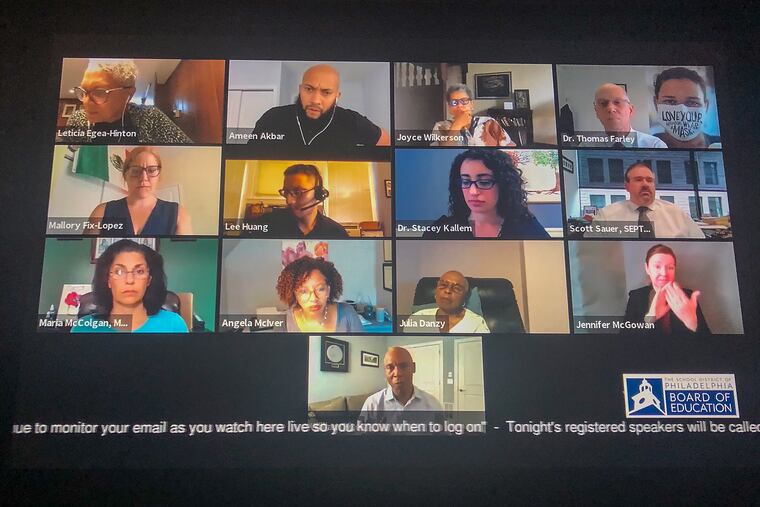Philly schools’ initial reopening plans spell disaster | Opinion
As the School District goes back to the drawing board, here's what it needs to consider.

One day after Philadelphia banned gatherings of 50 or more until February 2021, the School District announced plans for mega-gatherings in our city schools this fall. The school reopening plan, which was slammed by over 100 principals, teachers, parents, and students in a virtual meeting Thursday night, is a blueprint for social disaster. In response to the outcry, the district claims it’s going back to the drawing board to address concerns.
But the plan is fundamentally flawed. Leaving aside the riskier aspects — such as mask breaks with students eating together in the same room — or the problems not addressed — like crowded SEPTA buses that deliver students to and from schools — the most basic elements are also dangerous. The plan calls for most staff and about half the student body in a school to be in the building Monday through Thursday. For Lincoln High School, where I teach, even if 20% of the students opt to learn exclusively online, that would mean nearly 1,000 people in the same building, breathing the same poorly circulated air, every day.
Lincoln is one of the city’s most overcrowded schools. Our building was well over capacity last year, with more than 2,000 students and staff entering every day. Between classes, it was near impossible to move without bumping into other people. Every classroom was in use every period. Teachers not teaching had few places to go, other than a shared staff room. Our school had so little space, we converted our library into three makeshift classrooms, removing all the books and installing dividers.
» READ MORE: Philly’s school reopening plan is put on hold after an outcry: ‘We should not have to teach students to death’
Although not all schools are as overcrowded as Lincoln, many factors make reopening schools a dangerous gamble: poor ventilation and air-filtration systems, windows that don’t open, bathroom sinks that don’t work, a lack of basic school supplies that force students to share resources. In other words, decades of disinvestment in Philadelphia’s public schools have made them ideal places to spread COVID-19.
When you combine these concerns with the increasing evidence that the coronavirus is airborne, the recent news linking the spread of COVID-19 cases amongst children in sleepaway camps, and the alarming increase in children testing positive in Texas, Tennessee, Oregon, and Florida, it’s not surprising that leaked internal CDC documents called reopening schools the “highest risk” for spreading the coronavirus.
Philadelphia closed schools on March 16 with only nine confirmed cases of COVID-19 in the city. Our average daily new cases since the beginning of July is over 100. The countries that have successfully reopened schools did so by first dramatically containing the pandemic. We’re doing precisely the opposite.
At the same time, Philly schools have received only enough funding to barely plug a budget hole created by the economic crisis that has accompanied the pandemic. This will not be sufficient to drastically lower class sizes, reduce overcrowding, hire more cleaning staff, or any of the measures that would allow us to begin a real conversation about how to safely reopen schools. And let’s not forget that our district is still in the midst of an asbestos crisis that has poisoned teachers and students for decades. This is why many are skeptical that even the most basic safety measures in the district’s reopening plan will be implemented.
» READ MORE: ‘Every teacher I know is flipping out:’ As pandemic back-to-school plans form, educators are wary
As a parent worried about my daughter’s social and emotional health after having to isolate her for months from other children, and as an educator who deeply values collaborative in-person learning, I sympathize with parents and teachers who are ready to sweep online learning into the dustbin of history. But as flawed as remote learning is, it doesn’t lead to death, and reopening our school buildings will, not only for students and staff but also for families and communities. Furthermore, the masked socially distanced learning that students will return to will be a far cry from the relationship- and discussion-rich collaborative learning that makes face-to-face classes so much better than remote instruction.
This summer, Philadelphians took part in the historic uprising that screamed “Black Lives Matter!” If we take this slogan seriously, we need to look closely at what could happen in our schools that serve a majority Black student population. Black Philadelphians have contracted COVID-19 at nearly twice the rate of white Philadelphians, and make up more than 50% of the city’s coronavirus deaths. The risk of reopening schools is much higher for communities of color. Furthermore, increased policing of students who don’t follow mask-wearing guidelines that many adults struggle with could intensify the school-to-prison pipeline.
As the testimonies at Thursday’s meeting made clear, if Black lives matter, if educators’, students’, and their loved ones’ lives matter, we need to halt the reopening of schools, begin planning for better remote instruction, and fight for policies that curb the virus and address the child care needs of working parents.
Adam Sanchez teaches African American history at Lincoln High School in Philadelphia and is an editor of Rethinking Schools.